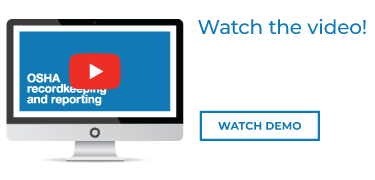OSHA update: wrangling recordkeeping and reporting requirements — again

You might be asking “what now?”
I thought OSHA was done with changes regarding electronic submission of OSHA injury and recordkeeping forms by employers to comply with reporting requirements deadlines.
Recall, the compliance schedule, based on the previous new rule by OSHA, requires employers to annually submit injury and illness information already being kept to OSHA electronically.
This previous rule required:
- establishments with 250 or more employees in industries routinely required to keep records to electronically submit information from their annual OSHA Form 300 (log of work-related injuries and illnesses), 300A (summary of work-related injuries and illnesses), and 301 (injury and illness incident report) to OSHA once a year, and
- establishments with 20 to 249 employees in certain designated (high-risk) industries are required to electronically submit information from their OSHA annual Form 300A (summary of work-related injuries and illnesses) to OSHA once a year.
Originally, these requirements became effective on January 1, 2017 with an initial electronic submission deadline of July 1, 2017. However, on November 24, 2017, OSHA officially changed the recordkeeping regulation to extend the initial electronic submission deadline for the 2016 Form 300A data from July 1, 2017 to December 1, 2017, then further extended to December 15, 2017 for all establishments with 250 or more employers and certain (high-risk) establishments with 20 to 249 employees.
NOTE: Reason for the deadline extensions was OSHA’s Injury Tracking Application (ITA) website was not available for use by employers in time for the initial electronic submission deadline of July 1, 2017. OSHA eventually adjusted the deadline to December 15, 2017.
Cyber-attack incident: On August 14, 2017, OSHA received an alert from the U.S. Computer Emergency Readiness Team (US-CERT) in the Department of Homeland Security that indicated a potential compromise of user information for OSHA’s Injury Tracking Application (ITA) which had opened for public access starting on August 1, 2017. The ITA was taken offline as a precaution. After a complete scan was conducted by the National Information Technology Center (NITC), it was confirmed that there was no breach of the data in the ITA and that no information was compromised. Public access to the ITA was restored on August 25, 2017.
So, what’s new?
Two more changes coming to OSHA reporting requirements to improve the process for employers
On July 30, 2018 OSHA issued a Notice of Proposed Rulemaking (NPRM) as follows.
- Eliminate the requirement to electronically submit information from OSHA Form 300 and OSHA Form 301 for establishments with 250 or more employees that are currently required to maintain these injury and illness records forms. These establishments would be required to annually electronically submit information only from OSHA Form 300A.
Reason for this requested change is to protect worker privacy by ending the electronic collection of case-specific forms (which OSHA has preliminarily determined adds uncertain value, but poses a potential privacy risk under the Freedom of Information Act) while continuing the electronic collection of summary forms (which adds significant enforcement value, with little privacy risk). - Require covered employers to submit their Employer Identification Number (EIN) electronically along with their injury and illness data submission (OSHA Form 300A).
Reason for this requested change is that OSHA believes this requirement can reduce or eliminate duplicative reporting. Collecting EINs would increase the likelihood that the Bureau of Labor Statistics (BLS) would be able to match data collected by OSHA under the electronic reporting requirements to data collected by BLS for the Survey of Occupational Injury and Illness (SOII). The BLS records already contain the EINs for establishments, and including the EIN in the OSHA collection will increase the accuracy of matching between the OSHA-collected data and the BLS-collected data.
Note: if you want further details on these proposed changes and the rationale for doing them, here’s the link to OSHA’s NPRM information in the July 30, 2018 issue of the Federal Register.
So, as it currently stands today...
- Effective, as of July 30, 2018 (date the NPRM above was issued), OSHA is not accepting electronically Form 300 and 301 information.
- Employers can continue to electronically report their calendar year (CY) 2017 Form 300A data to OSHA, but submissions after July 1, 2018 will be flagged as “Late”.
- Beginning in 2019 and every year thereafter, only the Form 300A (summary of work-related injuries and illnesses) for the previous calendar year — with EIN information — must be electronically submitted by March 2.
Last, if you had any question about what OSHA would do with the initial electronic submission by employers of Form 300A data, OSHA announced on October 17, 2018 that it is initiating the Site-Specific Targeting 2016 (SST-16) Program using injury and illness information electronically submitted by employers for calendar year (CY) 2016. This program will target high injury rate establishments in both the manufacturing and non-manufacturing sectors for inspection. Under this program, the agency will perform inspections of employers the agency believes should have provided Form 300A data, but did not for the CY 2016 injury and illness data collection.
Key resources for OSHA injury and illness recordkeeping and reporting:
- The latest details about OSHA injury and illness recordkeeping and reporting requirements.
- Listing of certain industries with establishments of 20 to 249 employees that must electronically submit OSHA form 300A.
- Injury tracking application (ITA) for electronic submission of injury and illness records to OSHA.

